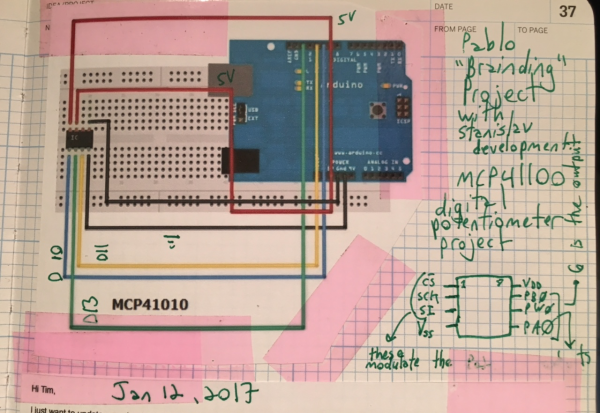Hi Dan! Great to be here.
 Hi Tim, let's get started. Welcome to the Hack Chat everyone, I'm Dan and I'll be moderating along with @Dusan Petrovic today. We're pleased to welcome Tim Marzullo from Backyard Brains today to talk about DIY neuroscience. Hope everyone brought a brain to hack ;-)
Hi Tim, let's get started. Welcome to the Hack Chat everyone, I'm Dan and I'll be moderating along with @Dusan Petrovic today. We're pleased to welcome Tim Marzullo from Backyard Brains today to talk about DIY neuroscience. Hope everyone brought a brain to hack ;-)
 Tim, can you tell us a little about your background?
Tim, can you tell us a little about your background?
 Hi Dan, welcome everyone!
Hi Dan, welcome everyone!
 Hi everyone! I am Tim Marzullo, co-founder and scientists at Backyard Brains.
Hi everyone! I am Tim Marzullo, co-founder and scientists at Backyard Brains.
 I have an undergraduate degree in Biochemistry from the University of Texas at Austin.
I have an undergraduate degree in Biochemistry from the University of Texas at Austin.
 and my doctorate in neuroscience from the University of Michigan. I studied the electrical impulses of brain neurons in rats in a Neural Engineering lab specializing in electrode design
and my doctorate in neuroscience from the University of Michigan. I studied the electrical impulses of brain neurons in rats in a Neural Engineering lab specializing in electrode design
 But I come from a background of high school teachers - my parents and grandparents have old told high school
But I come from a background of high school teachers - my parents and grandparents have old told high school
 So I was interested in bringing the technology we were using in graduate school into the high school.
So I was interested in bringing the technology we were using in graduate school into the high school.
 I approached my labmate Greg Greg about this, and Backyard Brains was born
I approached my labmate Greg Greg about this, and Backyard Brains was born
 I consider myself a decent prototype engineer.
I consider myself a decent prototype engineer.
 In my spare time I like to bike ride and ride.
In my spare time I like to bike ride and ride.
 I am pretty active in the USA, South Korea, and Chile.
I am pretty active in the USA, South Korea, and Chile.
 That's me a couple years ago biking in the Andes
That's me a couple years ago biking in the Andes
 and here's a drawing of some of our inventions
and here's a drawing of some of our inventions
 Not seeing the pix -- are you using the Image button below the chat window?
Not seeing the pix -- are you using the Image button below the chat window?

 it's just slow uploading
it's just slow uploading
 Ah, sorry. Cool drawings -- look almost hand-colored
Ah, sorry. Cool drawings -- look almost hand-colored

 yep, they are!
yep, they are!
 nice drawings :) when you talk about electrode design out of interest do you mean probing individual neurons? would that be a matrix of electrodes then?
nice drawings :) when you talk about electrode design out of interest do you mean probing individual neurons? would that be a matrix of electrodes then?
![]() Hi @Tim !
Hi @Tim !
Thanks for taking the time to chat with us.
I'm a big fan of backyard brains; got the BYB Toolbox a while ago, and have thoroughly enjoyed going through some of the experiments.
Still looking for a cockroach to cyborg-ize, though :P
 Using photolithography to make silicon arrays with multiple electrode sites on them.
Using photolithography to make silicon arrays with multiple electrode sites on them.
 The lab spun off into a company now.
The lab spun off into a company now.

Home
The global leader in neural probes, systems, and custom neural interface solutions. NeuroNexus products are used to advance neuroscience in nearly 1,000 institutions, in 50 countries.
cheers, that sounds really interesting, not heard of that approach before
Great to hear @Juan Carlos Jimenez
I remember the electrophysiology labs in my old day job, they did a lot of patch-clamp experiments looking at ion flux across membranes through a very fine micropipette. Are experiments like that doable for the DIYer?
The photo above is a two day Neural Engineering workshop I ran at a high school in the southern part of the Republic of Korea
We studied hearts, muscles, brains, and plant electricity
 Doing the patch clamp experiments is a dream for Backyard Brains
Doing the patch clamp experiments is a dream for Backyard Brains
 as many high school teachers have asked us to make a DIY replica of the classic Hodgkin/Huxley squid experiments
as many high school teachers have asked us to make a DIY replica of the classic Hodgkin/Huxley squid experiments
 but we would need to develop the suction electrode and the voltage clamp amplifier
but we would need to develop the suction electrode and the voltage clamp amplifier
 something we have not done yet
something we have not done yet
![]() Very difficult to transport pipettes which are that fine I expect
Very difficult to transport pipettes which are that fine I expect
 Yes you often handmake them in the laboratory
Yes you often handmake them in the laboratory
 I remember the setups for those rigs were pretty complex. They even did them in a Faraday cage. Just pulling the micropipette might be hard for the home-gamer.
I remember the setups for those rigs were pretty complex. They even did them in a Faraday cage. Just pulling the micropipette might be hard for the home-gamer.
 Yes that's why to stick to pin electrodes. Our classic cockroach experiments literally use map pins soldered to speaker wire
Yes that's why to stick to pin electrodes. Our classic cockroach experiments literally use map pins soldered to speaker wire

![]() The ways of imaging and taking inputs from the brain are very interesting but I have found the current technology for this is very low resolution spatially, usually only mapping areas of neurons.
The ways of imaging and taking inputs from the brain are very interesting but I have found the current technology for this is very low resolution spatially, usually only mapping areas of neurons.
Do you know about any methods in development that might allow for higher resolution brain imaging? I'm really excited to follow progress on this front.
 See how simple it is?
See how simple it is?
 Hello!
Hello!
Nowdays I do local field potential measurements in my PhD studies. I wonder what kind of filters do you use in your setup. Linear (FIR, IIR), or also non-lienar ones. Do you have any research in noise and artifact cancellation?
 @stupidtrash45 That's a fundamental problem with brain recording technologies
@stupidtrash45 That's a fundamental problem with brain recording technologies
 Spatial versus temporal resolution
Spatial versus temporal resolution
 There are 10,000 neurons per cubic millimeter of brain tissue
There are 10,000 neurons per cubic millimeter of brain tissue
 fMRI can sample the whole brain but has low temporal resolution (2-4 seconds)
fMRI can sample the whole brain but has low temporal resolution (2-4 seconds)
 Brain penetrating electrodes offer high temporal resolution but currently you put penetrating electrodes all over the brain
Brain penetrating electrodes offer high temporal resolution but currently you put penetrating electrodes all over the brain
 Problem hasn't been solved yet
Problem hasn't been solved yet
![]() Yeah, it's going to be so exciting when we finally break through and find a solid method
Yeah, it's going to be so exciting when we finally break through and find a solid method
 Penetrating electrodes -- isn't that what Musk is doing with those pigs?
Penetrating electrodes -- isn't that what Musk is doing with those pigs?
 @Kiss Ádám Cool! I recorded motor cortex LFPs in rats during one chapter of my dissertation. The filters we use fairly staigtht-forward - resistor and capacitor in parallel for a low pass filter, etc
@Kiss Ádám Cool! I recorded motor cortex LFPs in rats during one chapter of my dissertation. The filters we use fairly staigtht-forward - resistor and capacitor in parallel for a low pass filter, etc
 I worked a little bit on stimulus triggered averaging
I worked a little bit on stimulus triggered averaging
is your dissertaion available online?
https://deepblue.lib.umich.edu/handle/2027.42/61629
Deep Blue Home
Here you go!
stimulus triggered averaging is usually referred to as Evoked Potentials.
@Dan Maloney Yes but Musk was in the somatosensory cortex, recording from the part of the brain that receives sensory signals from the snout. To really "get into the matrix" you would need to put electrodes all over the brain (so we think). And nobody is anywhere near that right now.
Have you heard of this technique mentioned in - https://spectrum.ieee.org/automaton/robotics/drones/smellicopter-drone-live-moth-antenna it sounds like it might work with your amplifiers etc. to sense smell (I need to read their paper, very curious how the spikes or whatnot relate to different smells)
@QRPduwaynes Yeah it was for some experiments recording and stimulating at the same time on 16 channels. We were trying to use stimulus triggering across the 16 channels to remove the stimulus artifact from our recordings.
Us
@anfractuosity Yes that a very Backyard Brains style project.
*We used spikerboxes in my undergraduate biomedical instrumentation courses. It was one of the coolest labs ever!
We have had college interns record from the moth as well. https://blog.backyardbrains.com/2018/06/becoming-a-mothmom/
@Preston Thanks that makes us happy to hear.
oh thanks, will look at your blog post, hadn't seen that
Stim artefact, muscle artefact,, and external electrical interference is the major problem with any neuro study.
@QRPduwaynes Yes part of our outreach is teaching people to embrace noise.
@QRPduwaynes Electrophysiology is the eternal fight against noise.
Do you have any thoughts on ways of using consumer neurotech in AR/VR applications? Or just thoughts on the general consumer neurotech market at the moment (personal EEG and tDCS headsets, etc.)?
We love EEG
re. VR, i saw a very cool demo using multiple EMG sensors on the hand, to detect hand movement
Hi Tim! Good to see you! I'm curious what new secret projects/products Backyard Brains is working on!
After more than 25 years in field service installing servicing and teaching the use of EEG, EP NCV, EMG systems Noise is not your friend.
Hi Lex, glad you joined. Thanks for helping me set this up with Tim!
@Preston But we feel one of our responsibilities at Backyard Brains to educate the public on what the EEG can and can't do, as there is a lot of hype and startups that oversell it out there.
@Lex Kravitz seconded, what does the future hold?
 We have simple interfaces where you can control a tone with your EEG, but it is slow.
We have simple interfaces where you can control a tone with your EEG, but it is slow.
 alpha power in the visual cortex
alpha power in the visual cortex
 some of the most interesting applications I have seen recently is the ability to use surface EMG signals to control prostetics.
some of the most interesting applications I have seen recently is the ability to use surface EMG signals to control prostetics.
 @Lex Kravitz Good to hear from you! One of the exciting directions is BYB IoT. You know the human-human-interface. During the pandemic a high school teacher asked us if we could make a human-human-interface over the internet. We having a working prototype, and next week, we will do the demo of all demos at a local high school, where a person in Korea will control a person in Chile. It's still deep R&D though as we figure out scalability issues with our servers to have multiple devices hooked up.
@Lex Kravitz Good to hear from you! One of the exciting directions is BYB IoT. You know the human-human-interface. During the pandemic a high school teacher asked us if we could make a human-human-interface over the internet. We having a working prototype, and next week, we will do the demo of all demos at a local high school, where a person in Korea will control a person in Chile. It's still deep R&D though as we figure out scalability issues with our servers to have multiple devices hooked up.
 @Lex Kravitz and on the fundamental R&D side, we have developed a human conduction velocity protocol where you can compare the speed of nerves in your arm versus your legs (your arms are faster). The dream of dreams, human nerve recordings (but of course averaged over many stimulations)
@Lex Kravitz and on the fundamental R&D side, we have developed a human conduction velocity protocol where you can compare the speed of nerves in your arm versus your legs (your arms are faster). The dream of dreams, human nerve recordings (but of course averaged over many stimulations)

 This was done with our Korean team
This was done with our Korean team
 We are stimulating the ulnar nerve and recording the evoked potential in the fingers in Terry.
We are stimulating the ulnar nerve and recording the evoked potential in the fingers in Terry.
 @QRPduwaynes Yes we love EMG interfaces as acquiring the signal is very straightforward. We have EMG interfaces to control robotic claws, LCD screens, video games, music, etc.
@QRPduwaynes Yes we love EMG interfaces as acquiring the signal is very straightforward. We have EMG interfaces to control robotic claws, LCD screens, video games, music, etc.

 What happens when you stimulate the nerve? Flexion of the wrist perhaps?
What happens when you stimulate the nerve? Flexion of the wrist perhaps?
 There are many uses of nerve conduction studies. One of the main ones is finding the conduction velocity of different nerves in the same appendage. This is helpful in diagnosing things like Carpel tunnel syndrome.
There are many uses of nerve conduction studies. One of the main ones is finding the conduction velocity of different nerves in the same appendage. This is helpful in diagnosing things like Carpel tunnel syndrome.
![]() Regarding visual cortex EEG, have you seen the brain-computer interface developed by Next mind? ( next-mind.com ) Do you think they might be overselling the system's capabilities? It's kind of unbelievable; I didn't know EEG analysis had evolved to the point of making interfaces that high-level possible
Regarding visual cortex EEG, have you seen the brain-computer interface developed by Next mind? ( next-mind.com ) Do you think they might be overselling the system's capabilities? It's kind of unbelievable; I didn't know EEG analysis had evolved to the point of making interfaces that high-level possible
 @Lex Kravitz Haha yes you can imagine one person hooked to someone on every continent.
@Lex Kravitz Haha yes you can imagine one person hooked to someone on every continent.
 @Dan Maloney Yes when you stimulate the nerve you get contraction of the fingers and you also feel "pins and needles" in your fingers (the sensory part). You do an average of 50 stimulations and you see the evoked potential (as in the image I showed you).
@Dan Maloney Yes when you stimulate the nerve you get contraction of the fingers and you also feel "pins and needles" in your fingers (the sensory part). You do an average of 50 stimulations and you see the evoked potential (as in the image I showed you).
 @Juan Carlos Jimenez I want to believe. But there's two mantras we say at Backyard Brains, 1) "If it really worked, we'd all be using it". and 2) "Show me the demo" not a slick marketing video
@Juan Carlos Jimenez I want to believe. But there's two mantras we say at Backyard Brains, 1) "If it really worked, we'd all be using it". and 2) "Show me the demo" not a slick marketing video
 These companies tend to raise a bit of capital but then usually fold once hype meets reality. But, again, I want to believe and wish them luck.
These companies tend to raise a bit of capital but then usually fold once hype meets reality. But, again, I want to believe and wish them luck.
![]() This might be a stupid thing to ask but do you think it would be possible to infer arm movement based on electrodes on the arm if you trained a neural network to correlate electrode inputs with an input that tracked how the arm was positioned such as a camera feed or some mechanical sensors?
This might be a stupid thing to ask but do you think it would be possible to infer arm movement based on electrodes on the arm if you trained a neural network to correlate electrode inputs with an input that tracked how the arm was positioned such as a camera feed or some mechanical sensors?
 @EggsBiscuits That's not a dumb question. We had a similar project a few years ago that was abandoned due to signal classification problems. https://backyardbrains.com/experiments/RobotHand Now that AI tools are becoming easier to use, maybe we could reanimate this project. Internally we have begun investigating how to make BYB AI projects. We get asked for it all the time
@EggsBiscuits That's not a dumb question. We had a similar project a few years ago that was abandoned due to signal classification problems. https://backyardbrains.com/experiments/RobotHand Now that AI tools are becoming easier to use, maybe we could reanimate this project. Internally we have begun investigating how to make BYB AI projects. We get asked for it all the time
Using surface EMG you can get a fairly good idea of the level of muscle contraction. If you can calibrate lets say arm movement with the level of the ENG signal you could get a good approximation of movement at different EMG levels. Problem is to have enough sensors on all the muscles involved
100%. they do have a few demos available on youtube ( ), and apparently sent units to different youtubers for reviews. Sadly the software requirements (visual patterns on the different actionable locations) probably mean it won't be widely adopted --IMHO
 @Juan Carlos Jimenez cool. This an EEG interface we did with a local electronic music artist.
@Juan Carlos Jimenez cool. This an EEG interface we did with a local electronic music artist.
 Hey all, we're coming up on 1:00 PM here and we're about out of time. We like to let our hosts get back to work if they need to, so I'll say a huge thanks to Tim for his time today, and to Lex for helping to set this up. Thanks a ton for the great chat, and thanks to everyone for stopping by. Hack Chat is always open, though, so keep the conversation going. Thanks!
Hey all, we're coming up on 1:00 PM here and we're about out of time. We like to let our hosts get back to work if they need to, so I'll say a huge thanks to Tim for his time today, and to Lex for helping to set this up. Thanks a ton for the great chat, and thanks to everyone for stopping by. Hack Chat is always open, though, so keep the conversation going. Thanks!

https://blog.backyardbrains.com/2017/03/brainding-project-commences-with-first-working-prototype/
BRAINDING Project Commences with First Working Prototype
Longtime Backyard Brains fans may recognize Pablo Guerra in the majority of our human interface videos. When not acting for Backyard Brains, Pablo Works as Electronic Music Artist, specifically, modifying electronic music instruments in a discipline called "Circuit Bending."
 I'm so late... looks like is stil going.
I'm so late... looks like is stil going.
![]() Ohh that experiment looks great :) Gotta give it a try!
Ohh that experiment looks great :) Gotta give it a try!
 Sorry you missed it -- but I will post a transcript in a few minutes if you want to review the chat
Sorry you missed it -- but I will post a transcript in a few minutes if you want to review the chat
 @Lex Kravitz @Dan Maloney Thanks for inviting me, I enjoyed interacting with you all ;)
@Lex Kravitz @Dan Maloney Thanks for inviting me, I enjoyed interacting with you all ;)
 Running through now. @Tim et.al. you're work is really neat to read about and see performed.
Running through now. @Tim et.al. you're work is really neat to read about and see performed.
 Dan Maloney
Dan Maloney

Discussions
Become a Hackaday.io Member
Create an account to leave a comment. Already have an account? Log In.